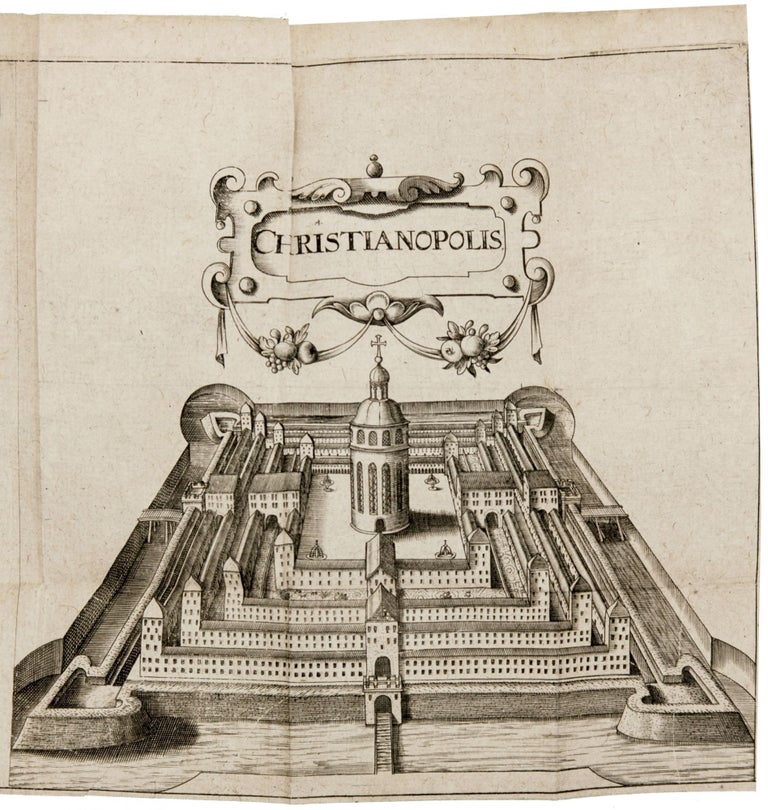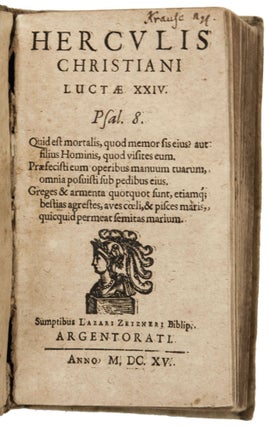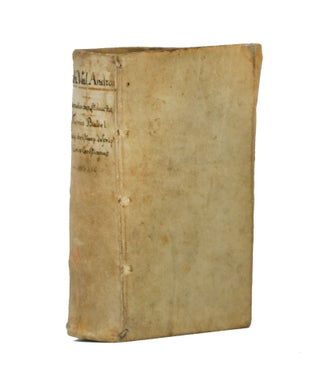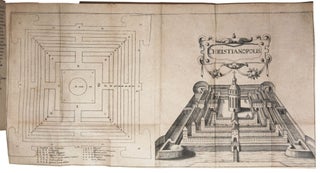Reipublicae Christianopolitanae descriptio.
12mo. 220 pp., (4) ff., blank, except for the third, which has errata printed on recto; with a folding engraved plate depicting Christianopolis.
[Bound first:] Herculis Christiani luctae XXIV. Strasburg, Lazarus Zetzner, 1615. (2) ff., [1-]54, 59-62, 3 blank leaves; note: lacking pages 55-58 (c6-7).
[Bound second:] Turris Babel sive Judiciorum de Fraternitate Rosaceae Crucis Chaos. Strasburg, heirs of Lazarus Zetzner, 1619. 72 pp.
[Bound last:] Civis Christianus, sive Peregrini quondam errantis restitutiones. Strasburg, heirs of Lazarus Zetzner, 1619. 235 pp., 2 blanks. Four works in one vol. Very lightly browned as usual; excellent copies in contemporary yapped vellum, spine lettered in ink; early inscription in ink on upper margin of the Herculis Christiani luctae (bound first); 18th C notes on rear free end-paper; 19th C bookplate of ‘James Brown Thornton’ on front paste-down.
Fine sammelband of four scarce first editions of works by the Renaissance theologian, Lutheran reformer, and self-proclaimed founding Rosicrucian Johann Valentin Andreae (1586-1654), including his celebrated Reipublicae Christianopolitanae, a Protestant vision of the Christian Utopia. The volume includes a folding engraved plate, often missing, depicting two views of the perfect city: a bird’s-eye view of its walls, courtyards, and central tower, together with an aerial blueprint of its symmetrical architectural layout.
Like its famous predecessor, More’s Utopia (1516), Andreae’s Christianopolis describes the ideal Christian society from the perspective of a visiting narrator, in this case the shipwrecked pilgrim Cosmoxenus Christianus, who observes the city’s inhabitants, social institutions and way of life. As Thompson has remarked, however, the work’s “blueprint for establishing a small community of scholar-craftsmen”—in contrast to the stratified castes of Utopia—marks it as “a Lutheran alternative to the Jesuit collages of the counter-reformation, and a Christocentric alternative to the Rosicrucian myth” with which Andreae was also associated. Many of the work’s 100 chapters, e.g. The Library, The Pharmacy, The Natural Science Laboratory, Mathematical Instruments, Astrononomy etc., also testify to Andreae’s education in the humanities and natural sciences: he read Erasmus and Lipsiu, studied mathematics under Maestlin, and corresponded with Kepler until the latter’s death in 1630.
Manuel also notes that, unlike Utopia or Campanella’s City of the Sun (a near-contemporary of the present work), the progress of Andreae’s narrator through his surroundings represents a private spiritual journey, one that perhaps prefigures Bunyan’s Pilgrim’s Progress (1678): “Christianopolis is the history of an adept in an ideal Lutheran community, and the alterations of his inner being, his exaltation through the sight of the meticulously ordered Christian city, is the heart of the work.”
Bound first in the volume is Andreae’s Herculis Christiani luctae, which includes veiled biographical material on his Tübingen friend and mentor Tobias Hess (1558-1614); Christianopolis is followed by Turris Babel (1619), an anonymously published satire of the Rosicrucian movement, and Civis Christianus, a didactic examination of religious hermeticism.
OCLC:
Reipublicae Christianopolitanae: Getty, Yale, Illinois, Harvard, Cornell, Colgate Rochester. Also Wellcome.
Turris Babel: Getty, Illinois, Cornell, Colgate Rochester, also Wellcome.
Herculis Christiani: Colgate Rochester.
Civis Christianus: Getty, NLS.
(The 1916 definitive English translation of Reipublicae Christianopolitanae by Held is available online, as is the original Latin text of 1619; a new English edition was issued in 1999 and is owned by many American libraries. Also online in full-text is the 1619 Civis Christianus.)
* Reipublicae: Dünnhaupt 23 (‘Erster evangelisch orientierter utopischer Staatsroman im Geiste von Moore’s Utopia und Campanella’s Sonnenstaat’), Faber du Faur I.128, Gardner 38; Herculis: Cimelia Rhodostaurotica 46, Gardner 30; Turris: Cimelia Rhodostaurotica 285, Gardner 39; Civis: Cimelia Rhodostaurotica 284, Gardner 42. Also cf. Manuel, Utopian Thought in the Western World, pp. 289-305; Johann Valentin Andreae's Utopian Brotherhoods Author(s): Donald R. Dickson Source: Renaissance Quarterly, Vol. 49, No. 4 (Winter, 1996), pp. 760-802; .
Price: $14,500.00




